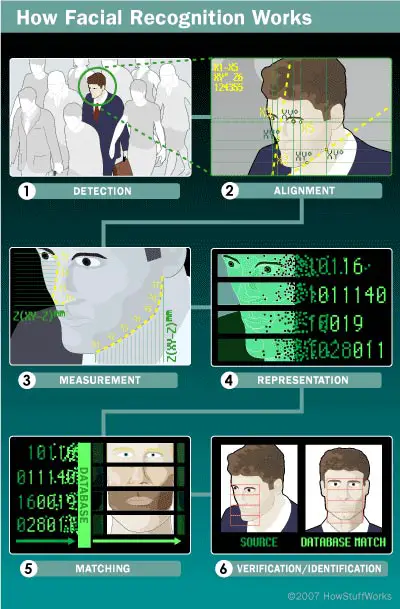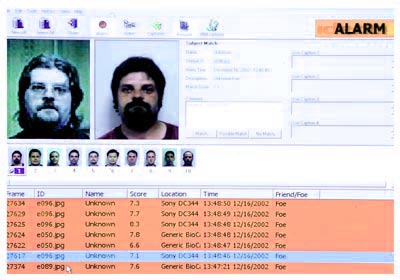We have seen the use of facial recognition technology in many movies. A photo of the person to be identified will be obtained from some hidden camera. It will then be run in through the police database so as to find a match with their existing records. At last a match will be found and the criminal will be caught red handed. Though this may seem fascinating in movies, it may not be the same in real world.
The facial recognition system was equipped in cameras and was placed in some streets so as to cut down the number of crimes in the area. But, the technology failed to provide results as the people around the streets wore masks, prohibiting the cameras from getting a clear enough shot to identify anyone.
The facial recognition software’s have been upgraded well enough to provide 99% accuracy at present. In this post, we will discuss about the origin of this technology and also their enhancing capabilities for both governmental and personal use.
From the phrase facial recognition, it is understood that the software used for this purpose mainly recognizes a number of distinguished features of the face. All the features added together make almost 80 nodal points. The software used for facial recognition recognizes and distinguishes the face from its background by some of the common nodal points given below.
- Distance between the eyes
- Nose width
- Depth of the eye sockets
- Cheekbone shape
- Length of jaw-line
The above nodal points are measured altogether to provide a common numerical code known as the face print.
Early Stages
As explained earlier, the software that is needed for the technology could only compare a 2-D image of a person with the existing database. The software was very weak in technicality as correct results were difficult to obtain if the photo was not taken in the correct lighting and with good facial expressions. As these types of photos are taken instantly and in a secretive manner there would be changes in orientation and click angles. When these photos were compared with the database, no results were ever found. Thus, this system was mostly rejected by all authorities.
3-D Facial Recognition Technology
To get a better understanding, take a look at the image below.

The above explained problems were all resolved with the evolution of 3-D Facial Recognition Technology. As a 3-D image of a person’s face helps to point out clearly the different nodal points, this method proved to be more accurate. All the valleys and bumps of the face are more apparent and this helps a lot in comparing with the database.
The 3-D method also removes the disadvantage of correct lighting aspects. Thus, the photo of the person can be taken even in improper lighting and that too in any angle [in a range of almost 90 degrees]. Given below are the different steps that take place when the identity of a person is verified with an existing database.
Detecting the person
To know the proper working of this process, take a look at the image shown below.
The image that is to e compared with the database is obtained either as a photo [2-D] or as a video image [3-D].
Alignment of image
For a 2-D image, the system can be accurate only if the angular position of the face towards the camera is at least 35 degrees. But for a 3-D image, the system can be accurate even if the angular position of the face towards the camera is at 90 degrees. The size and pose can also affect the accuracy.
Measurement of face
The face recognition software makes templates on the different curves of the face. The face will be measured in micrometer scales.
Transfer of Measurement
The measurement taken is then transferred into a unique code. This code makes each template unique and thus represents the different features of the face.
Matching with database
The comparison of the image with the database can occur in two ways. If both the image taken and the image in the database are 3-D, then there is no problem in the matching process.
But, as the database in most government offices and other places are present in 2-D form, the comparison becomes more complex. The 3-D image has to be converted to a 2-D image before comparison. A 3-D image will be live and moving when compared to a still and stable 2-D image. So, when a 3-D image is take, it is converted to 2-D by taking measurements from some distinguished points from the face. These measurements will then be converted to an algorithmic form and thus will be converted to a 2-D image.
Comparison
The comparison can be classified into two according to its purpose. One of them is verification and the other is identification.
If a person is to be identified as one who claims to be an employee of a particular office, it is called verification. This type of comparison will with the database will only take place in a 1:1 ratio. That is,
For the identification of a thief or a culprit, the image received will be compared to all the images in the database in a 1: N ratio. Take a look at the comparison process shown in the image below.

- Face Comparison
The comparison process is usually done in three different templates. They are
Vector Template – This template is used for quick search with the database in both the 1:1 and 1:N ratio.
Local Feature Analysis [LFA] – This template mostly follows the vector template. This search is a little more complex.
Surface Texture Analysis [STA] – This is the most complex search template of all the three. It comes after the LFA and the search is based on the skin features of the image, which contains the most detailed information.
When these templates are combined in the facial recognition software, the system is able to recognize and identify the person even if there are changes in his expressions like smiling, frowning and also blinking. Even a moustache growth or beard will not affect the accuracy of the software.
But, there are disadvantages as well. A glare from the person wearing eyeglasses can cause problems. If the person is disguised as one with long hair in such a way that it covers the front part of the face, it will be difficult to identify him. Very poor lighting during the time of photography may cause the face to be under exposed. This can also be a problem.
Uses of Facial Recognition System
This technology was first used by law enforcement agencies so as to identify people from huge crowds. This system was also adopted to catch people trying to fraud while voting. The system was also used in airports to check whether the foreigners visiting the country had any resemblance to criminals or suspects.
Another important application of this technology is in ATM’s and check-cashing security. Before transacting the money, a photograph of the person is taken and is verified with the database to see whether the customer is valid. Thus identity theft and fraudulent transactions can be avoided. This system is very useful as there will be no need of personal identification number for any person. But this type of a transaction process is yet to come in many places.

2 Comments
thanks.it is very usedul to me
Informative post!